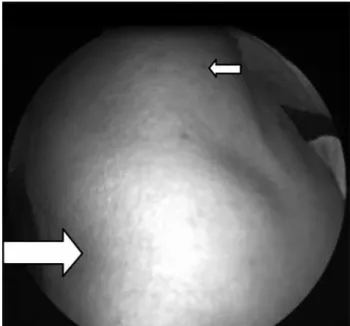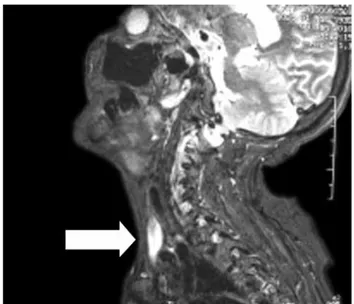260 Kulak Burun Bogaz Ihtis Derg 2010;20(5):260-263
Case Report / Olgu Sunumu
B
EH
BUT
CEVA
NŞİR KULAK BURUN BOĞ
AZHA STAL IK LA RI VE BAŞ B OYUN CERRAHİSİDERN EĞİ . .
Pulsatile oropharyngeal and neck mass caused by bilateral
tortuous internal carotid artery: a case report
İki taraflı kıvrımlı internal karotis arterin neden olduğu pulsatil orofarengeal ve
boyun kitlesi: Olgu sunumu
Güçlü Kaan Beriat, M.D.,1 Hande Ezerarslan, M.D.,1 Sinan Kocatürk, M.D.,1 Ali Fuat Mıhmanoğlu, M.D.,2 Erkan Kuralay, M.D.2
The cervical course of the internal carotid artery is almost straight in contrast to the intracranial portions which are highly tortuous. The incidence of variations in the cervical course of the internal carotid artery of the population is approximately 10-40 percent. In this case report, a 76-year-old female patient with a pulsatile mass at the posterior oropharyngeal wall and anterior neck was presented. Physical examina-tion revealed a pulsatile anterior neck mass, and a pulsatile mass at the right posterior wall of the oro-pharynx. Imaging revealed a bilateral tortuous inter-nal carotid artery and segmental left interinter-nal carotid arterectomy and distal internal carotid artery - lateral common carotid artery anastamosis were performed with no postoperative complications.
Key Words: Neck mass; oropharyngeal mass; tortuous internal carotid artery.
İnternal karotis arterin servikal seyri, intrakraniyal parçasının yüksek derecede kıvrımlı olmasına karşın oldukça düzdür. İnternal karotis arte-rin servikal seyarte-rindeki değişikliklearte-rin toplumdaki oranı yaklaşık %10-40 civarındadır. Bu olgu sunu-munda ağız boşluğu arka duvarında ve boyun ön kısmında kitlesi olan 76 yaşında kadın hasta sunuldu. Fizik muayenesinde ağız boşluğu arka duvarının sağ tarafında ve boyun ön kısmında pulsatil kitle izlendi. Yapılan incelemelerde iki taraflı kıvrımlı internal karotis arteri saptandı ve segmental sol internal karotis arterektomi ve distal internal karotis artere - lateral ortak karotis artere anastomoz uygulandı, ameliyat sonrası komplikasyon olmadı.
Anahtar Sözcükler: Boyun kitlesi; orofarengeal kitle; kıvrımlı internal karotis arter.
The cervical course of the internal carotid artery (ICA) is almost straight in contrast to the intracra-nial portions which are highly tortuous. However anatomic variations are present like ICA elonga-tion abnormalities which may be classified as coiling, looping, kinking or tortuosities of the vessels.
The prevalence of these anomalies has not been studied within healthy populations. The incidence of variations in the cervical course of the ICA has been reported as 10-40% of the population in sys-tematic postmortem statistics.[1] These anomalies can result in ischemic hemispheric and ocular events in some stenotic cases. These anomalies are Department of 1Otolaryngology, 2Cardiovascular Surgery, Medicine Faculty of Ufuk University, Ankara, Turkey
Received / Geliş tarihi: March 25, 2010 Accepted / Kabul tarihi: May 26, 2010
Correspondence / İletişim adresi: Hande Ezerarslan, M.D. Güvenlik Cad., Bodur Apt., No: 46/ 7, 06540 Aşağı Ayrancı, Çankaya, Ankara, Turkey. Tel: +90 312 - 467 77 08 Fax (Faks): +90 312 - 284 77 86 e-mail (e-posta): handearslan5@yahoo.com
261 Pulsatile oropharyngeal and neck mass caused by bilateral tortuous internal carotid artery: a case report
rarely symptomatic. For this reason, the literature includes low numbers of patients over a long time span. If the artery contacts with the oropharyngeal or nasopharyngeal wall, terrible complications may occur in routine procedures.
In this article, we present a case of pulsatile oro-pharyngeal and neck masses caused by bilateral tortuous ICA.
CASE REPORT
A 76-year-old woman was admitted to our clinic with the symptoms of obstructive sensation in the throat and history of an anterior neck mass within the last 4-5 years. The obstructive symptom has gradually progressed with accompanying dyspnea at night. She was on treatment of hypertension for eight years and had a history of temporary right side stroke one year ago.
Physical examination revealed a pulsatile ante-rior neck mass, and a pulsatile mass at the right posterior wall of the oropharynx (Figure 1, 2). The oropharyngeal mucosa and neck skin were normal. An abnormality of the carotid artery was suspect-ed, and magnetic resonance imaging showed that the ICA was projecting toward the right pharynx and right side of the neck (Figure 3). Angiography demonstrated kinking of the upper segment inter-nal carotid artery bilaterally and the tortuous ICA at lower anterior neck (Figure 4, 5). No other aneu-rysm or tumor was detected in the neck.
The patient was referred to the cardiovascu-lar surgery clinic. Segmental left internal carotid arterectomy was performed for the kinking seg-ment and the distal ICA was connected to the lat-eral side of the common carotid artery (Figure 6). No complication occurred in the early postopera-tive period.
DISCUSSION
The tortuous cervical ICA abnormalities are com-monly observed in the outpatient clinics of otolar-yngology. Angiographic studies demonstrated the incidence of this abnormality as 3-12 percent.[1]
The exact cause of vascular tortuosity is unknown. Atherosclerosis and congenital defor-mities are thought to be the two main causes of this abnormality.[2] It is also speculated that, if the abnormality has a congenital origin, atheroscle-rosis and hypertension may aggravate it in older ages. Our 76-year-old hypertensive patient who suffered from stroke was consistent with the litera-ture in terms of hypertensive and atherosclerotic etiology causing tortuosity of ICA.
Our patient complained of a pulsatile neck mass, throat obstruction and dyspnea. We thought that these symptoms were caused by a narrowing in the oropharyngeal space. After detailed exami-nation, a vascular problem was suspected and magnetic resonance imaging and magnetic reso-nance angiography were performed which showed ICA tortuosity.
Figure 1. The pulsatile mass was located at the posterior wall of oropharynx (showed by small arrow) at the right. Round pulsating bulging of the right oropharyngeal was seen extending to uvula.
Figure 2. The pulsatile mass was located at the midline bottom of the neck. Small arrow shows trachea at the midline of the neck.
262 Kulak Burun Bogaz Ihtis Derg
Head and neck surgeons frequently operate in the oropharynx and nasopharynx with the limited exposure offered by transoral access. It is important that otolaryngologists recognize ICA elongation anomalies, because they may cause fatal hemorrhage during surgical procedures such as tonsillectomy, adenoidectomy, biopsy and drainage of peritonsillar abscess.[3] Radiologic evaluation is essential before surgical procedures for oropha-ryngeal and neck masses. Magnetic resonance
imaging is a non-invasive method to visualize the abnormality of vessels together with the surround-ing soft tissues. Angiography confirms the diagno-sis of this vascular abnormality.
Commonly, these abnormalities are asymptom-atic but the symptoms might reflect as sudden onset of blindness, transient ischemic attack and stroke.[4] Figure 3. The magnetic resonance imaging showed the internal
carotid artery which was projecting towards the right pharynx (arrows) and narrowing the oropharyngeal
cavity on the axial and coronal views. Figure 4. Right tortuous internal carotis artery.
263 Pulsatile oropharyngeal and neck mass caused by bilateral tortuous internal carotid artery: a case report
Our patient had a history of transient ischemic attack one year ago. Tortuous ICA can also be a cause of pseudotumor in the retropharyngeal space.[5,6] The tortuous ICA presenting with an abnormal sensa-tion in the throat is uncommon.[7] Besides, no case a mass in the neck and oropharynx with bilateral ICA tortuosity has been reported in the literature.
Tortuous ICA needs no treatment as long as the patient does not have a cerebrovascular ischemic sign. We treated our patient in order to protect against a second left hemispheric ischemic attack by resection of tortuous part of ICA and anastomo-sis to the common carotid artery.
In conclusion, manual and ocular exploration of an abnormal pulsation in the neck must never be omitted. It is not always easy to detect all cases of aberrant ICA or ICA transposition during clinical exploration; therefore, we recommend the use of ICA arteriography and magnetic resonance angi-ography in the preoperative evaluation of those patients that present asymmetry of the posterior pharyngeal wall. Radiologists should bear in mind this anomaly and alert the clinician to its existence, even when it is an incidental finding in otherwise asymptomatic patients. Otolaryngologists must recognize this anomaly to avoid a serious
compli-cation and the patient should be made aware of their condition.[4,8]
REFERENCES
1. La Barbera G, La Marca G, Martino A, Lo Verde R, Valentino F, Lipari D, et al. Kinking, coiling, and tortuosity of extracranial internal carotid artery: is it the effect of a metaplasia? Surg Radiol Anat 2006; 28:573-80.
2. Weibel J, Fields WS. Tortuosity, coiling, and kinking of the internal carotid artery. I. etiology and radiographic anatomy. Neurology 1965;15:7-18.
3. Tomiya Y, Chiba S, Moriyama H, Kikuchi Y, Ohta M. Eighteen cases of tortuosity of the internal carotid-usefulness of MR-angiography in diagnosis. Nippon Jibiinkoka Gakkai Kaiho 1995;98:1367-72. [Abstract] 4. Mc Kenzie W, Woolf CI. Carotid abnormalities and
adenoid surgery. J Laryngol Otol 1959;73:596-602. 5. Leipzig TJ, Dohrmann GJ. The tortuous or kinked
carotid artery: pathogenesis and clinical consider-ations. A historical review. Surg Neurol 1986;25:478-86. 6. Johnson RE, Stambaugh KI, Richmond H, Balbuena
L. Tortuous internal carotid artery presenting as an oropharyngeal mass. Otolaryngol Head Neck Surg 1995;112:479-82.
7. Pratt LW, Gallagher RA. Tonsillectomy and adenoidec-tomy: incidence and mortality, 1968-1972. Otolaryngol Head Neck Surg 1979;87:159-66.
8. Sichel JY, Chisin R. Tortuous internal carotid artery: a rare cause of oropharyngeal bulging diagnosed by magnetic resonance angiography. Ann Otol Rhinol Laryngol 1993;102:964-6.

